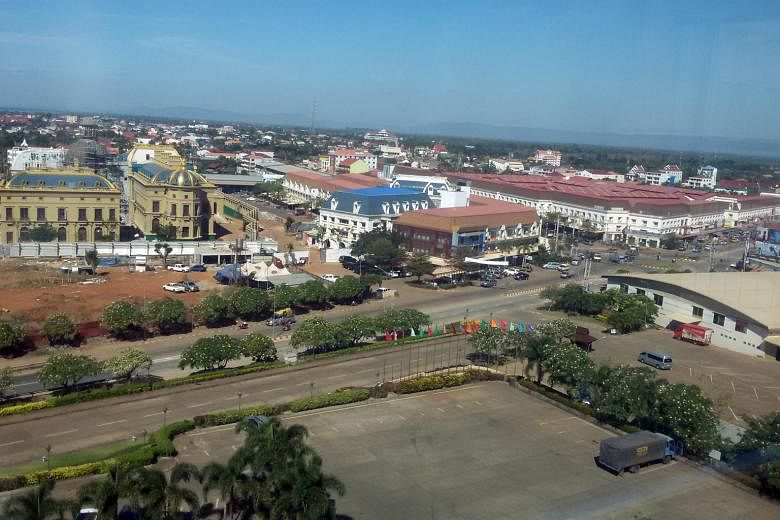This year, China-based entrepreneur Shu Wenbin spent most of his Chinese New Year holidays doing business.
Besides meetings across China, Mr Shu, a general manager with Continental Interior Design and Construction, sought potential partners elsewhere, including in the United States. The firm is a small and medium-sized enterprise (SME) that offers interior design and construction services.
"China's real estate and construction industries have slowed down, new residential and commercial projects are seeing sluggish growth, and investment projects are uncertain," he told China Daily. "Overseas markets, especially in South-east Asia and South America will be new growth points. Prospects in European and US markets are also good."
Mr Shu's company employs 150 people and manages an annual revenue of 300 million yuan (S$62 million), of which nearly 20 per cent is from overseas. He aims to lift that figure to 50 per cent by 2017.
Slower growth in the construction sector and rising labour and material costs have made it important for ventures like this to search for new opportunities globally.
The Government's move to make it easier for ventures to make overseas investments has helped. And indications are that there would be other firms following the same path.
China's outbound investment hit US$140 billion (S$190 billion) in 2014, exceeding its inbound investment of US$120 billion for the first time, according to figures from the country's Ministry of Commerce.
President Xi Jinping wants that figure to reach US$1.25 trillion over the next decade, the paper reports.
Ambassador Wu Jianmin, former president of China Foreign Affairs University and a member of the Los Angeles-based Berggruen Institute's 21st Century Council, said: "We are on the verge of a big wave of Chinese companies going global. Many companies have realised that if they don't look for opportunities globally, they will probably die in China finally."
A push to encourage SMEs to become competitive, think big and reach out to markets beyond borders is getting some attention across Asia, including in Singapore.
Singapore Finance Minister Heng Swee Keat's maiden Budget this year saw a series of new initiatives for SMEs. The list includes raising corporate income tax rebate from 30 per cent to 50 per cent, capped at $20,000 each year for Year of Assessment 2016 and 2017. And the Special Employment Credit, which was due to expire this year, will be modified and extended to the end of 2019, with a top-up of $1.1 billion. This will provide employers with a wage offset for workers aged 55 and above who earn up to $4,000 a month.
Similar initiatives are in the works elsewhere, given a growing realisation that the seeds of future growth potential might well lie in nimble, smaller-sized ventures that can react faster to disruptive technological changes and offer employment opportunities to many more, as nations restructure and rethink their economic strategies.
SMEs across the Asia-Pacific contribute 20 per cent to 50 per cent of their respective nation's gross domestic product growth, employ half the workforce and account for over 90 per cent of all enterprises, Apec data shows.
However, their contribution to exports is only a third.
Given their potential, policymakers are looking at easing policy constraints, improving the availability of affordable capital, creating schemes to improve the skills of employees, setting up dedicated zones for SMEs, improving infrastructure and doing more to allow them to make the leap to overseas markets.
This is driven in part by moves to increase trade within the region and beyond, with the Asean Economic Community declaration already in place, and talks for other trade partnerships, among them the Regional Comprehensive Economic Partnership and the Trans-Pacific Partnership.
Also, there are proposals to increase connectivity between countries by air and land. China's New Silk Road Economic Belt initiative to link China with Europe, and the 21st Century Maritime Silk Road, which will connect China with South-east Asian countries, Africa and Europe, will mean more opportunities for smaller players.
Take a look at what's happening:
• South Korea is turning to SMEs to remedy its dramatic drop in exports, for which it banked on large conglomerates till now. The nation's exports registered a decline of 18.5 per cent in February, over that a month earlier, making it the largest monthly drop since August 2009. In March, that figure was 8.2 per cent, the 15th consecutive month of a drop in exports, one of the key pillars of the nation's economic growth. As a result, it has been decided that the central bank, the Bank of Korea, will make available nine trillion won (S$10 billion) in low-interest loans for SMEs, in a bid to reinvigorate the economy, The Korea Herald reports.
• Indonesia has announced subsidised loans from Exim Bank for export-oriented SMEs, besides insurance for 70 per cent of the loans given to SMEs. There are plans to remove over two dozen subsectors from the negative investment list, with many key segments to be set aside for smaller businesses. According to a report by The Jakarta Post, Coordinating Minister for Economic Affairs Darmin Nasution noted: "SMEs have the potential to produce export-based goods that can help diversify Indonesia's export market." The measures, he hopes, will help them to export directly instead of first selling to bigger conglomerates in the country.
• Laos, which has established a special economic zone in Champassak province to encourage Japanese SMEs to invest in the country, recently held a meeting with 200 Japanese firms to promote bilateral trade. Mr Khamphon Nuansengsy, president of the Champassak Special Economic Zone, told the Vientiane Times that he hopes the initiative will create enough jobs to attract people from neighbouring areas, and alleviate poverty.
• Thailand is urging its SMEs to target markets in Asean, and announced a budget of 400 million baht (S$15 million) to help them to do so. The funds will be available for SMEs with innovative products, new product designs and those which are environmentally friendly. This will be the country's second SME Proactive Project, The Nation newspaper reported. Thailand's first SME Proactive Project (from 2013 to 2015) helped 2,602 SMEs generate a combined income of 8.89 million baht.
• Taiwan plans to host meetings on SMEs with Asia-Pacific economies this year, and there are plans to open a skills development centre in Taichung, the China Post reported. With an eye on the potential, DBS Taiwan launched a "SME mini-term loan" for SMEs this year.
Given the push to develop SMEs, Mr Andrew Sheng, a Distinguished Fellow with the Asia Global Institute who writes regularly for ANN on Asian issues, believes the next Apple could very well come from Asia.
"It is more likely to be an Asian start-up, because of the massive efforts of Asian governments in fostering new entrepreneurship," he wrote in a recent commentary.
"Never have so many SMEs been able to access so much knowledge and so many markets with such speed and ease. The era of small companies in new markets is only just beginning... Governments will do well to foster the eco-system for innovation and change."
But there is quite some distance to go. Thailand, for instance, wants to modernise its farming sector, turning farmers into small-scale entrepreneurs like in Japan, South Korea and Taiwan. For this, the government is extending affordable loans and investing in digital technology, to enable e-commerce to take off.
But agricultural owners face several challenges - among them land erosion, poor fertility and productivity issues. There is also the question of educating the farmers and ensuring they can invest in better farming techniques.
South Korea is finding it hard to encourage its young to join SMEs, given the difference in wage structures. Such is the challenge that the government recently announced a wealth creation scheme for the young who opt to join SMEs.
Under this plan, a young person who gets a job at an SME and puts away three million won in his bank account for two years would be offered an additional six million won and three million won by the government and his employer, respectively, the Korea Herald reports.
Then, there is the reluctance within the banking system to lend, given current economic realities.
Last month, Hong Kong's commerce chief Gregory So Kam-Leung wrote to the city's banks, urging them to support SMEs - the territory boasts over 30,000 of them.
With the global economy showing no signs of recovering, almost every bank would become more cautious on sanctioning loans, especially to debt-ridden SMEs which have a comparatively low-risk tolerance, Hong Kong-based Hanna Li Wai-han, a strategist at UOB Kay Hian, told China Daily.
"Subdued exports data, the gloomy outlook of the city's retail sector and weakening market sentiment are all weighing on balance sheets of local SMEs," she said.
- The Asia News Network is an alliance of 22 newspapers. The Straits Times is a founding member of the network and all papers quoted in this article are part of the network.


